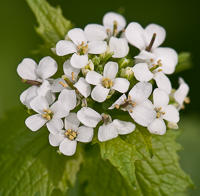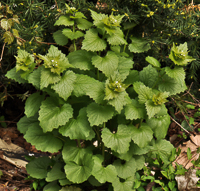 Garlic mustard (Alliaria petiolata) is a
biennial herb in the mustard family. Plants can range in
height from 5 to 46 inches. The first year plants form rosettes of
kidney-shaped leaves. In its second year, the plant grows a stem with leaves
that are triangular and sharply toothed. The flowers are born in a cluster at
the end of the stem, and each small flower has four white petals. Seeds are
black, oblong and found in rows within a long narrow capsule called a silique.
Crushed leaves and stems of this plant give off a distinctive garlic odor.
Garlic mustard (Alliaria petiolata) is a
biennial herb in the mustard family. Plants can range in
height from 5 to 46 inches. The first year plants form rosettes of
kidney-shaped leaves. In its second year, the plant grows a stem with leaves
that are triangular and sharply toothed. The flowers are born in a cluster at
the end of the stem, and each small flower has four white petals. Seeds are
black, oblong and found in rows within a long narrow capsule called a silique.
Crushed leaves and stems of this plant give off a distinctive garlic odor.
Habitat
 Garlic mustard grows in rich, moist upland forests, and
wooded stream banks. It is shade tolerant and readily invades disturbed areas
such as roadsides and trail edges. Garlic mustard cannot tolerate acidic
soils, including undrained peat or muck.
Garlic mustard grows in rich, moist upland forests, and
wooded stream banks. It is shade tolerant and readily invades disturbed areas
such as roadsides and trail edges. Garlic mustard cannot tolerate acidic
soils, including undrained peat or muck.
Native to
Europe and Asia, garlic mustard is now found in
Canada, south to Virginia, and as far west as Kansas and Nebraska. It is
believed to have been brought to
North
America by European settlers for use in
cooking and medicine.
Prolific seed production and lack of natural predators
which might feed on garlic mustard allow it to quickly dominate the ground
cover. Native herbs in competition with garlic mustard may suffer population
declines.
Control
Light infestations of garlic mustard can be controlled by
hand-pulling. Plants should be pulled before seeds have ripened. Care must be
taken to insure the entire root is removed and disturbance of the soil is
minimal.
 Severe infestations can be controlled with
herbicides.
Garlic mustard is biennial. Its first year growth overwinters as a basal
rosette of kidney-shaped leaves, therefore it is still green when many other
herbs have died or gone into dormancy. Foliar application of a
glyphosate
herbicide (Roundup, Kleenup, etc.) can be made in late fall to minimize damage
to other plants. Follow-up treatments may be necessary over two or three years
to get target plants that were missed, as well as new sprouts.
Severe infestations can be controlled with
herbicides.
Garlic mustard is biennial. Its first year growth overwinters as a basal
rosette of kidney-shaped leaves, therefore it is still green when many other
herbs have died or gone into dormancy. Foliar application of a
glyphosate
herbicide (Roundup, Kleenup, etc.) can be made in late fall to minimize damage
to other plants. Follow-up treatments may be necessary over two or three years
to get target plants that were missed, as well as new sprouts.
Glyphosate herbicides are recommended because they are
biodegradable, breaking down into harmless components on contact with soil.
However, glyphosate is a nonselective, systemic herbicide and will affect all
green vegetation. To be safe and effective, herbicide use requires careful
knowledge of the chemicals, appropriate concentrations, and the effective
method and timing of their application.



